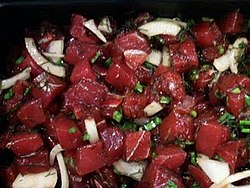Poke (Hawaii)

|
|
| Type | Salad |
|---|---|
| Course | Appetizer |
| Place of origin | United States |
| Region or state | Hawaii |
| Main ingredients | Yellowfin tuna, sea salt, soy sauce, inamona, sesame oil, limu seaweed, chili pepper |
| |
|
Poke /poʊˈkeɪ/ is a raw fish salad served as an appetizer in Hawaiian cuisine, and sometimes as an entree. Poke is the Hawaiian verb for "section" or "to slice or cut". Traditional forms are aku (an oily tuna) and he'e (octopus). He'e (octopus) poke is usually called by its Japanese name "Tako" Poke, except in places like the island of Ni'ihau where the Hawaiian language is spoken. Increasingly popular ahi poke is generally made with yellowfin tuna. Adaptations may feature raw salmon or various shellfish as a main ingredient served raw with the common "poke" seasonings.
Poke began with fishermen seasoning the cut-offs from their catch to serve as a snack. Traditional poke seasonings have been heavily influenced by Japanese and other Asian cuisines. These include soy sauce, green onions, and sesame oil. Others include furikake (mix of dried fish, sesame seeds, and dried seaweed), chopped dried or fresh chili pepper, limu (seaweed), sea salt, inamona (roasted crushed candlenut), fish eggs, wasabi, and Maui onions. Other variations of poke may include cured heʻe (octopus), other types of raw tuna, raw salmon and various kinds of shellfish.
The traditional Hawaiian poke consists of fish that has been gutted, skinned, and deboned. It is sliced across the backbone as fillet, then served with traditional condiments such as sea salt, candlenut, seaweed, and limu.
According to the food historian Rachel Laudan, the present form of poke became popular around the 1970s. It used skinned, deboned, and filleted raw fish served with Hawaiian salt, seaweed, and roasted, ground kukui nut meat. This form of poke is still common in the Hawaiian islands.
...
Wikipedia
